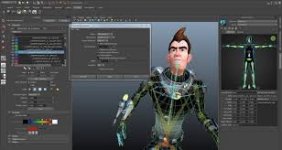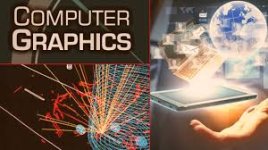Computer Graphics: From Basics to Applications
Introduction
Computer graphics is one of the most fascinating and rapidly growing fields in computer science. It refers to the creation, manipulation, and representation of visual images and data using computers. From video games and movies to simulations and user interfaces, computer graphics plays a crucial role in modern digital experiences. As technology continues to evolve, so too does the scope and sophistication of computer graphics.
What is Computer Graphics?
Computer graphics involves the use of computers to generate images and visual effects. It combines elements of design, art, mathematics, and programming to create images that can be displayed on a screen or printed on paper. Graphics can be 2D (like photographs, drawings, or flat designs) or 3D (such as animated characters, simulations, and virtual environments).
There are two main types of computer graphics:
- Raster Graphics – Made up of pixels. Examples include digital photographs and bitmap images.
- Vector Graphics – Made up of paths defined by mathematical expressions. Examples include logos, illustrations, and scalable graphics.
History and Evolution
The roots of computer graphics date back to the 1950s when engineers and scientists began exploring ways to display images on cathode-ray tube (CRT) monitors. The development of the Sketchpad system in the early 1960s by Ivan Sutherland marked a significant milestone. It allowed users to draw directly on a screen with a light pen and is considered the foundation of interactive computer graphics.
Since then, computer graphics has advanced exponentially, with milestones such as:
- The invention of graphic user interfaces (GUIs)
- The rise of 3D rendering software
- The introduction of graphics processing units (GPUs)
- Real-time rendering for games and simulations
Core Concepts in Computer Graphics
1. Rendering
Rendering is the process of generating a final image from a model. This involves calculating lighting, texture, and shading to create a realistic or stylized image. Rendering can be real-time (as in video games) or offline (as in animated movies).
2. Modeling
Modeling refers to the creation of 3D objects and environments. It involves using mathematical techniques to represent surfaces, edges, and vertices. Popular 3D modeling tools include Blender, Maya, and 3ds Max.
3. Animation
Animation involves giving motion to objects. It can be frame-by-frame (traditional animation), keyframe-based, or physics-based. Techniques like motion capture are also used in modern animation.
4. Texturing and Shading
Texturing adds surface details like color, patterns, and bumps to a 3D model. Shading defines how light interacts with the surface of the object, giving it depth and realism.
5. Ray Tracing and Rasterization
Ray tracing simulates how light rays travel and interact with surfaces to create photorealistic images. Rasterization converts 3D models into 2D images for real-time applications like video games.
Applications of Computer Graphics
1. Entertainment and Media
One of the most prominent uses of computer graphics is in movies, television, and gaming. CGI (Computer-Generated Imagery) allows filmmakers to create realistic characters, environments, and special effects that are otherwise impossible to capture in real life.
2. Video Games
Computer graphics is at the heart of game development. It enables the creation of immersive 3D worlds, characters, and dynamic effects that respond in real time to user input.
3. Education and Training
Simulations and visualizations help in training professionals in fields like medicine, aviation, and military. Interactive 3D models make learning more engaging and effective.
4. Architecture and Engineering
Architects and engineers use computer graphics to create detailed blueprints, models, and walkthroughs of buildings, bridges, and machines. It helps in visualizing concepts before actual construction.
5. Virtual Reality (VR) and Augmented Reality (AR)
These technologies heavily rely on computer graphics to create virtual environments and overlay digital information on the real world.
6. Data Visualization
Computer graphics are used to visually represent data through graphs, charts, and infographics. This makes complex data easier to understand and analyze.
Tools and Technologies
Several software tools and programming languages are used in the development of computer graphics:
- Software: Adobe Photoshop, Illustrator, Blender, AutoCAD, Maya, Unity, Unreal Engine
- Languages: OpenGL, DirectX, WebGL, Vulkan, C++, Python, GLSL (Graphics Library Shading Language)
Challenges in Computer Graphics
Despite its vast applications, computer graphics also faces several challenges:
- Realism vs. Performance: Creating realistic graphics often requires high processing power.
- Cost: Developing high-quality graphics can be expensive in terms of time, talent, and hardware.
- Complexity: Designing, animating, and rendering complex models demands deep technical and artistic skills.
The Future of Computer Graphics
The future of computer graphics looks bright and promising. With advancements in artificial intelligence, machine learning, and cloud computing, we can expect more realistic, intelligent, and interactive graphics. Real-time ray tracing, neural rendering, and AI-assisted modeling are some emerging trends that will reshape how we create and interact with visual content.
Conclusion
Computer graphics is more than just pretty pictures on a screen. It is a dynamic field that merges science, technology, and creativity to shape the digital experiences we enjoy today. Whether in entertainment, education, design, or data analysis, the impact of computer graphics is far-reaching and continues to grow with technological evolution. As it becomes more accessible and sophisticated, it will play an even greater role in shaping our digital future.


